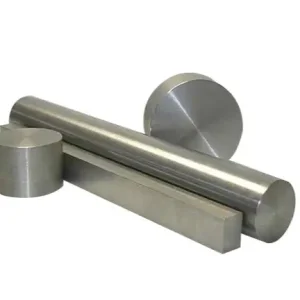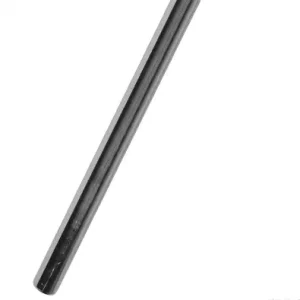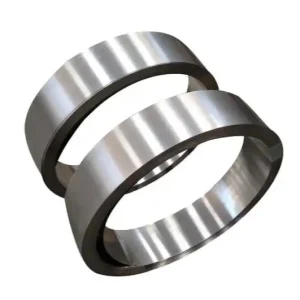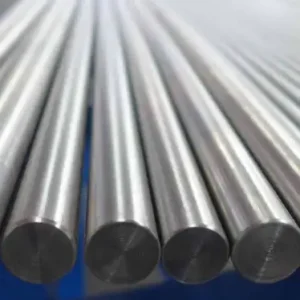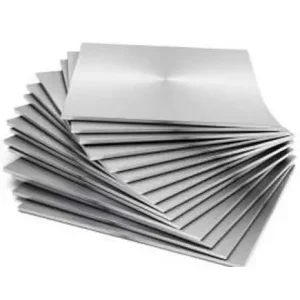Nimonic Alloys
Products
Nimonic alloys are a family of nickel-chromium, precipitation-hardenable superalloys engineered for high-temperature strength, low creep and long service life in gas-turbine and other extreme heat environments. For procurement, MWAlloys supplies standard Nimonic grades from China with factory pricing, rapid stock shipment, and machining/forging options for aerospace, power-generation, and industrial customers.
Nimonic refers to a branded family of nickel-based superalloys originally developed in the UK in the 1940s to meet the escalating demands of early jet engines. Typical formulations combine a nickel matrix with roughly 18–21% chromium plus strengthening additions (titanium, aluminium, cobalt, small carbon). Over successive grade developments (75 → 80A → 90 → 100 → 105 → 263 etc.), compositions were tuned for better creep resistance, oxidation resistance and mechanical stability at temperatures from roughly 600°C up to the 900–950°C range in specialized grades. These materials remain central to hot-section engine parts, high-temperature fasteners and critical industrial hardware.
What is a Nimonic alloy?
A Nimonic alloy is a nickel-chromium, heat-resistant superalloy that relies on a combination of solid-solution strengthening (Cr in Ni) and precipitation hardening (fine γ′ precipitates from Al/Ti) to retain strength under long-term high-temperature load. Typical metallurgical characteristics include: high creep-rupture life, good oxidation resistance, stable microstructure at operating temperature, and usable ductility for fabrication and welding in many forms (sheet, plate, bar, wire, tube, forgings). Commercial Nimonic grades are standardized with UNS, DIN/W-Nr., AMS/ASTM references used by procurement and engineering teams.
Common Nimonic grades
Below is a practical grade list that most engineers will encounter in specifications. It is not exhaustive, but it covers the widely used variants:
-
Nimonic 75 (UNS N06075 / W.Nr. 2.4951 / 2.4630) — early 80/20 Ni-Cr alloy with Ti/C, good sheet/strip use.
-
Nimonic 80A (UNS N07080 / W.Nr. 2.4631 & 2.4952) — age-hardenable Ni-Cr with Al/Ti, excellent up to ~815°C.
-
Nimonic 81 — higher Cr for better hot-corrosion resistance.
-
Nimonic 90 (UNS N07090 / W.Nr. 2.4632) — Ni-Cr-Co age-hardening alloy for very high stress at elevated temperature (service up to ~920°C).
-
Nimonic 100 — improved high-temperature creep properties over earlier alloys.
-
Nimonic 105 / 115 — further development for very high temp strength, often used in turbine components.
-
Nimonic 263 (sometimes referenced under other commercial names) — Ni-Cr-Co-Mo family optimized for strength and oxidation resistance in combustor/combustion-chamber parts.
Engineers should refer to the specific datasheet for mechanical/heat-treatment windows because each grade’s value derives from its composition and prescribed age-hardening/solution-treatment schedule.
Material properties
The table below gives characteristic, engineering-level properties for typical Nimonic alloys (numbers are indicative; consult the grade datasheet for certified values and heat-treatment condition).
| Property | Typical range / value (notes) |
|---|---|
| Density | ~8.18–8.40 g/cm³ (≈ 8180–8400 kg/m³) |
| Melting range | ~1270–1360 °C (depends on grade and minor alloying). |
| Usable service temp | 600°C → 950°C depending on grade (Nimonic 80A ≈ 815°C, Nimonic 90 ≈ 920°C). |
| Tensile strength (room temp) | ~600–900 MPa (annealed vs age hardened vary widely). |
| Creep resistance | Very good; many grades are optimized for long rupture life at elevated T. |
| Oxidation resistance | Excellent up to grade limit; chromium content gives protective oxide. |
| Weldability | Generally fabricable and weldable when following recommended procedures; some grades require post-weld heat treatment. |
Citation notes: datasheets from primary manufacturers and technical collections list these ranges precisely for each grade. Use the grade datasheet for final design and procurement.
Chemical composition
The following composition table condenses typical nominal ranges for commonly requested Nimonic alloys. These entries are representative; use certified mill test reports for procurement.
| Element (wt%) | Nimonic 75 (UNS N06075) | Nimonic 80A (UNS N07080) | Nimonic 90 (UNS N07090) | Nimonic 263 / (typical) |
|---|---|---|---|---|
| Nickel (Ni) | Balance (~≥69–78%) | Balance (≈69%) | Balance | Balance, high Ni |
| Chromium (Cr) | 18.0 – 21.0 | 18.0 – 21.0 | 18.0 – 21.0 | ≈18–20 (varies) |
| Cobalt (Co) | — or small. | ≤ 2% (80A small Co) | 15–21% (Nimonic 90 contains high Co) | 15–20% typical for Co-containing grades |
| Titanium (Ti) | 0.2 – 0.6 (75) | 1.8 – 2.7 (80A) | 2.0 – 3.0 (90) | 1.5–3.0 depending on grade |
| Aluminium (Al) | trace/small | 1.0 – 1.8 (80A) | 1.0 – 2.0 (90) | present for γ′ strengthening |
| Carbon (C) | 0.08 – 0.15 (75) | ≤ 0.10 typical | ≤ 0.13 typical | |
| Iron (Fe) | up to ~5% (75), lower in other grades. | |||
| Others (Mo, Nb) | small or absent in classic Nimonic; some modern variants carry Mo/Nb for specialized properties. |
Important: the exact certified composition must come from the mill certificate tied to the purchase order and physical lot. Use this table only for early engineering screening.
Standards and specification mapping
Engineering procurement usually references these identifiers:
-
UNS: e.g., N06075 (Nimonic 75), N07080 (Nimonic 80A), N07090 (Nimonic 90).
-
W-Nr / EN: e.g., W.Nr. 2.4951 / 2.4630 for 75; W.Nr. 2.4631 / 2.4952 for 80A.
-
ASTM / AMS / ASME: common product standards include ASTM B637 / ASME SB-637 for bars/forgings and other corresponding AMS specifications (AMS 5829 is linked to some Nimonic 90 product forms).
-
British Standards (BS HR/BS 3076): older but often referenced for legacy aerospace parts.
When writing procurement clauses, identify: grade + UNS/W-Nr + product form (bar/plate/forging/wire) + heat-treatment condition + required test certificates (chemistry, mechanical, PMI, grain size, NDT). For aerospace, include traceability and serialization clauses.
Typical applications
Nimonic alloys are chosen whenever sustained high temperature with mechanical load occurs:
-
Turbine blades, vanes, disks and bolting for jet engines and industrial gas turbines.
-
Exhaust valves and high-temperature springs in high-performance engines (automotive turbochargers, aviation).
-
Combustion chamber and afterburner components
-
Hot-section fasteners, studs and springs where creep matters.
-
Industrial furnace components, heat-treatment fixtures and nuclear engineering where controlled high-temperature behavior is needed.
Nimonic vs Inconel — clear engineering differences
Both Nimonic and Inconel are nickel-based superalloys but have distinct development histories and design goals:
-
Primary strengthening system: Nimonic grades typically use Ni-Cr matrices with Al/Ti-driven γ′ precipitation and often significant cobalt for higher temperature creep resistance in high-stress grades. Inconel family members include solid-solution strengthened types (e.g., Inconel 625) and age-hardenable types (e.g., Inconel 718) where Nb, Mo and Fe play larger roles.
-
Application focus: Nimonic historically emphasizes maximum creep/hot-strength for turbine hot sections; Inconel family offers a broader range from corrosion/oxidation resistant seawater/chemical grades (625) to high-strength age-hardenable 718 used widely in aerospace and industrial sectors.
-
Corrosion behaviour: Some Inconel grades with Mo/Nb show superior resistance to certain chemical and chloride environments; Nimonic excels at resisting high-temperature oxidation and creep.
For component selection, match operating temperature, environment (oxidizing/corrosive), mechanical loading and manufacturability. When in doubt, request service-condition test data and consult both datasheets for life-prediction modeling.
Typical sizes and weight estimates
Use density ≈ 8.20 g/cm³ (8,200 kg/m³) for order-of-magnitude weight calculations (check exact grade datasheet and mill certificate for final invoicing).
Plate / sheet (weight per m²)
| Thickness (mm) | Weight (kg/m²) |
|---|---|
| 1 mm | 8.20 kg/m² |
| 2 mm | 16.40 kg/m² |
| 5 mm | 41.00 kg/m² |
| 10 mm | 82.00 kg/m² |
| 25 mm | 205.00 kg/m² |
(Calculation: weight = thickness (m) × density (kg/m³) × 1 m²)
Solid round bar (weight per linear metre)
| Diameter (mm) | Weight (kg/m) |
|---|---|
| 6 mm | 0.232 kg/m |
| 8 mm | 0.412 kg/m |
| 10 mm | 0.644 kg/m |
| 12 mm | 0.927 kg/m |
| 16 mm | 1.649 kg/m |
| 20 mm | 2.576 kg/m |
| 25 mm | 4.025 kg/m |
| 32 mm | 6.595 kg/m |
| 40 mm | 10.304 kg/m |
| 50 mm | 16.101 kg/m |
(Round bar formula used; density = 8,200 kg/m³.)
These tables help estimate gross material weight for logistics and quoting. Verify with supplier for finished part tolerance allowance and machining loss. (Computed from standard geometric formulas using density ≈ 8.2 g/cm³.)
Global price snapshot 2025
Market quotations for Nimonic grades vary by product form, diameter/thickness, heat treatment, order size and supplier region. The figures below are indicative mid-2025 ranges derived from supplier price lists and market trackers; use them only for early budgetary estimates. Final quotes must be requested with drawing/spec and quantity.
| Region | Typical 2025 indicative price (USD / kg) — common forms |
|---|---|
| China (FOB/Factory) | US$ 30 – 60 / kg (sheets, plates, small bars from Chinese mills; very competitive MOQs). |
| Europe | US$ 45 – 95 / kg (plate and bar; stricter inspection & certification, premium for low-Co nuclear specs). |
| United States | US$ 80 – 140 / kg (small-volume aerospace-grade bars, tight lead times; brazed/forged items cost more). |
Notes and drivers:
-
Chinese suppliers often list lower FOB factory prices for commodity grades because of scale, local feedstock and lower labour margins; western stockists add inventory/processing margins.
-
Specialty aerospace/qualified material (serialized, full traceability, NADCAP processes) commands a premium and longer lead times.
-
Raw nickel price direction, melting route (VIM, VAR, ESR) and certification (vacuum-processed vs air melt) affect surcharges. Supplier surcharge indices show Nimonic variants with alloy surcharges that reflect base metal movements.
Market and technology trends
-
Aerospace & power demand growth: Forecasts show continued demand growth in nickel alloys for aero-engine and industrial gas turbines through the decade; this supports sustained interest in Nimonic and other high-temperature superalloys.
-
Nickel feedstock dynamics: A surplus in refined nickel capacity (notably Indonesian expansion) has pushed benchmark nickel prices down in 2024–2025, creating short-term cost relief for alloy buyers but also stress on primary producers and potential future supply adjustments. This volatility will continue to affect alloy surcharges and ordering decisions.
-
Additive manufacturing (AM): Interest in powder-bed and directed-energy deposition of high-Ni alloys for complex cooling passages and repair work is growing; some Nimonic chemistries are being adapted for AM feedstock development. Buyers should check material-spec compatibility for AM processes.
-
Qualification & supply chain localization: OEMs increasingly require audited supply chains, NADCAP-compatible heat treatments and documented traceability. This strengthens the premium for qualified western suppliers while creating opportunity for certified Chinese mills.
-
Sustainability & recycling: Reclaimed nickel content and closed-loop scrap practices influence cost and compliance; regulations across regions may require enhanced material provenance.
Practical buyer recommendation: for production or prototype projects, request both mill certificates and sample mechanical tests under intended operating conditions; negotiate alloy surcharge clauses tied to a widely-accepted index to reduce future price risk.
Why choose MWAlloys
MWAlloys supplies a range of Nimonic grades from our China manufacturing partners and selected stockists. Our standard service offering:
-
Product range: Nimonic 75, 80A, 90, 100 and related grades in plate, sheet, round bar, forging blanks and wire.
-
Certs & traceability: full mill test certificates (chemical, mechanical), optional PMI and NDT, serialization for aerospace orders.
-
Factory pricing: direct factory prices for competitive single-lot and repeat orders; we emphasize transparent FOB pricing, volume discounts and short lead times on stocked sizes.
-
Fast delivery: stock items ship from nearest Chinese warehouses; custom forgings and heat-treated lots ship according to agreed schedule; expedited processing available for serialized aerospace orders.
-
Value services: machining, precision forging, age hardening to specified T/T schedules and QC reporting.
Specification checklist for RFQ
When requesting quotes, include:
-
Grade (UNS / W-Nr. / AMS).
-
Product form (plate/bar/forging/wire), dimensions and tolerances.
-
Heat-treatment condition (annealed / solution + age) and hardness requirement.
-
Required certificates (MTC EN 10204 type 3.1 / AMS / NADCAP).
-
Quantity, delivery terms (FOB/CIF/DDP), and desired delivery window.
-
Special inspection: PMI, ultrasonic/penetrant testing, tensile test at temperature.
-
Packaging/identification (heat lot, bar marking).
Providing these upfront shortens quote turnaround and ensures MWAlloys and mill partners price accurately.
FAQs
1. Which Nimonic grade should I pick for turbine blade roots operating at 850–900°C?
For sustained loading at that band, older Nimonic 90 or modern high-temperature variants (90/105 family) are typical choices; final selection depends on load spectrum, environment and manufacturing route. Check creep-rupture curves from the datasheet.
2. Are Nimonic alloys weldable?
Yes, but welding procedures and post-weld heat treatment depend on grade. Some grades require careful PWHT to restore precipitation state. Always request welding guidance from the producer.
3. Can Nimonic be used in corrosive chemical environments?
Nimonic resists high-temperature oxidation well; however, for aggressive chemical or chloride environments, some Inconel or Hastelloy grades may be better. Specify environment before final material choice.
4 How are Nimonic prices set?
Prices track nickel and chromium benchmark movements plus processing (VIM/ESR/VAR) and certification premiums. Many suppliers add an alloy surcharge indexed to base metal price.
5. Is MWAlloys able to supply aerospace-qualified material?
Yes — for serialized aerospace orders we coordinate mills with the requested certifications and inspection protocols; lead times and premiums apply.
6. What lead times for standard Nimonic 80A bars from stock?
For stocked diameters, typical shipping can be 1–3 weeks from Chinese warehouses; custom forgings or special heat treatments add time. Confirm per RFQ.
7. Is Nimonic suitable for additive manufacturing?
Development work is ongoing; some Nimonic chemistries have powder-bed or DED variants. Qualification remains part-specific.
8. What test certificates are standard?
Mill Test Certificate (chemical + mechanical) to EN/ASTM formats is standard; higher levels (3.1, NADCAP records) on request for aerospace.
9. How to store Nimonic to avoid surface contamination?
Keep dry, protected from chloride salts and packaging oils; remove any residues before final heat treatment. Standard good practice prevents hot corrosion and contamination.
10. What is the main difference between Nimonic and Inconel?
Nimonic focuses on γ′ precipitation hardening and creep strength for hot-section turbine use; Inconel family includes both solid solution and age-hardened types with wider corrosion resistance options. Match alloy to environment and load.

